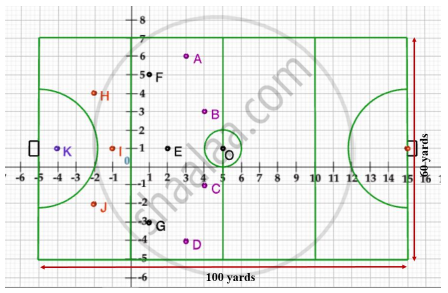Advertisements
Advertisements
प्रश्न
Determine whether the point is collinear.
P(–2, 3), Q(1, 2), R(4, 1)
उत्तर
By distance formula,
\[\mathrm{d}(\mathrm{P},\mathrm{Q})=\sqrt{\left(x_{2}-x_{1}\right)^{2}+\left(y_{2}-y_{1}\right)^{2}}\]
= \[\sqrt{\left[1- (-2)\right]^{2}+\left(2 - 3\right)^{2}}\]
= \[\sqrt{(1+ 2)^{2}+(2 - 3)^2}\]
= \[\sqrt{(3)^{2}+(- 1)^2}\]
= \[\sqrt{9 + 1}\]
∴ \[\mathrm{d}(\mathrm{P},\mathrm{Q}) = \sqrt{10}\] ...(i)
\[\mathrm{d}(\mathrm{Q},\mathrm{R})=\sqrt{\left(x_{2}-x_{1}\right)^{2}+\left(y_{2}-y_{1}\right)^{2}}\]
= \[\sqrt{(4 - 1)^{2} + (1 - 2)^{2}}\]
= \[\sqrt{3^{2} + (-1)^2}\]
= \[\sqrt{9 + 1}\]
∴ \[\mathrm{d}(\mathrm{Q},\mathrm{R}) = \sqrt{10}\] ...(ii)
\[\mathrm{d}(\mathrm{P},\mathrm{R})=\sqrt{\left(x_{2}-x_{1}\right)^{2}+\left(y_{2}-y_{1}\right)^{2}}\]
= \[\sqrt{[4 - (-2)]^{2} + (1 - 3)^{2}}\]
= \[\sqrt{6^{2} + (-2)^2}\]
= \[\sqrt{36 + 4}\]
= \[\sqrt{40}\]
= \[2\sqrt{10}\]
∴ \[\mathrm{d}(\mathrm{P},\mathrm{R}) = 2\sqrt{10}\] ...(iii)
On adding (i) and (ii),
\[\mathrm{d}(\mathrm{P},\mathrm{Q}) + \mathrm{d}(\mathrm{Q},\mathrm{R}) = \sqrt{10} + \sqrt{10} = 2\sqrt{10}\]
∴ d(P, Q) + d(Q, R) = d(P, R) …[From (iii)]
∴ Points P, Q and R are collinear.
APPEARS IN
संबंधित प्रश्न
Find the coordinates of the circumcentre of the triangle whose vertices are (8, 6), (8, – 2) and (2, – 2). Also, find its circum radius
If the opposite vertices of a square are (1, – 1) and (3, 4), find the coordinates of the remaining angular points.
Find the values of y for which the distance between the points P (2, -3) and Q (10, y) is 10 units.
If the points (2, 1) and (1, -2) are equidistant from the point (x, y), show that x + 3y = 0.
Show that the points A (1, −2), B (3, 6), C (5, 10) and D (3, 2) are the vertices of a parallelogram.
Show that the quadrilateral whose vertices are (2, −1), (3, 4) (−2, 3) and (−3,−2) is a rhombus.
Find the distance between the points
(i) A(9,3) and B(15,11)
Find all possible values of y for which distance between the points is 10 units.
Find value of x for which the distance between the points P(x,4) and Q(9,10) is 10 units.
The perimeter of a triangle with vertices (0, 4), (0, 0) and (3, 0) is ______.
Find the distance of the following point from the origin :
(0 , 11)
Find the distance between the following point :
(sin θ , cos θ) and (cos θ , - sin θ)
Find the distance between the origin and the point:
(-8, 6)
The length of line PQ is 10 units and the co-ordinates of P are (2, -3); calculate the co-ordinates of point Q, if its abscissa is 10.
Show that each of the triangles whose vertices are given below are isosceles :
(i) (8, 2), (5,-3) and (0,0)
(ii) (0,6), (-5, 3) and (3,1).
Find distance between point A(– 3, 4) and origin O
Show that the points (0, –1), (8, 3), (6, 7) and (– 2, 3) are vertices of a rectangle.
AOBC is a rectangle whose three vertices are A(0, 3), O(0, 0) and B(5, 0). The length of its diagonal is ______.
Case Study -2
A hockey field is the playing surface for the game of hockey. Historically, the game was played on natural turf (grass) but nowadays it is predominantly played on an artificial turf.
It is rectangular in shape - 100 yards by 60 yards. Goals consist of two upright posts placed equidistant from the centre of the backline, joined at the top by a horizontal crossbar. The inner edges of the posts must be 3.66 metres (4 yards) apart, and the lower edge of the crossbar must be 2.14 metres (7 feet) above the ground.
Each team plays with 11 players on the field during the game including the goalie. Positions you might play include -
- Forward: As shown by players A, B, C and D.
- Midfielders: As shown by players E, F and G.
- Fullbacks: As shown by players H, I and J.
- Goalie: As shown by player K.
Using the picture of a hockey field below, answer the questions that follow:

The point on y axis equidistant from B and C is ______.
If (a, b) is the mid-point of the line segment joining the points A(10, –6) and B(k, 4) and a – 2b = 18, find the value of k and the distance AB.
